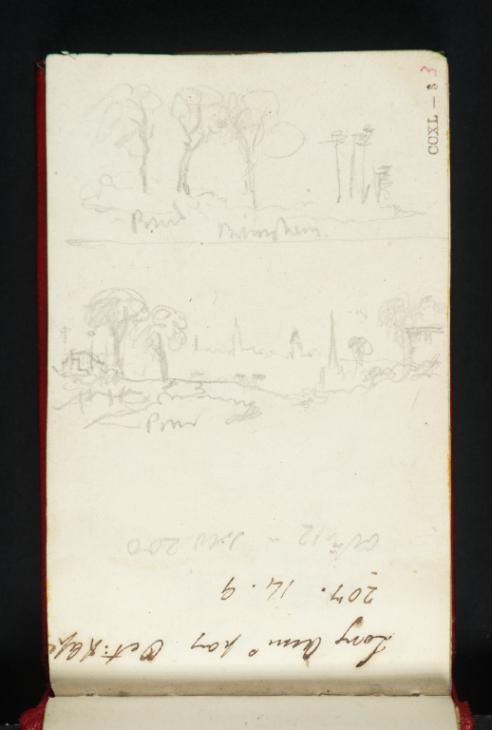Joseph Mallord William Turner Distant Views of Birmingham 1830
Image 1 of 2
Joseph Mallord William Turner,
Distant Views of Birmingham
1830
Joseph Mallord William Turner 1775–1851
Folio 3 Recto:
Distant Views of Birmingham 1830
D22327
Turner Bequest CCXL 3
Turner Bequest CCXL 3
Pencil and pen and ink on white wove paper, 110 x 68 mm
Partial watermark ‘Ga | 18’
Inscribed by Turner in ink and pencil with financial notes (see main catalogue entry), in pencil ‘Pond’ and ‘Birmingham’ towards top centre below drawing, and ‘Pond’ centre left below drawing
Inscribed by John Ruskin in red ink ‘3’ top right, ascending vertically
Stamped in black ‘CCXL – 3’ top right, ascending vertically
Partial watermark ‘Ga | 18’
Inscribed by Turner in ink and pencil with financial notes (see main catalogue entry), in pencil ‘Pond’ and ‘Birmingham’ towards top centre below drawing, and ‘Pond’ centre left below drawing
Inscribed by John Ruskin in red ink ‘3’ top right, ascending vertically
Stamped in black ‘CCXL – 3’ top right, ascending vertically
Accepted by the nation as part of the Turner Bequest 1856
References
1909
A.J. Finberg, A Complete Inventory of the Drawings of the Turner Bequest, London 1909, vol.II, p.738, CCXL 3, as ‘Two sketches of the “Pond, Birmingham”, and transcription.
With the page turned vertically with the gutter at the top, Turner made the following notes, the first two lines being in ink and the last in pencil:
Long Anns pay Oct: & Apl
207 . 14 . 9
Oct 12 sold 200
207 . 14 . 9
Oct 12 sold 200
The note refers to biannual interest payments on Turner’s long-term annuity investments. For similar financial notes on adjacent pages, see under folio 1 recto (D22323).
With the page turned vertically the opposite way, Turner made two sketches. The top one shows trees in an apparently rural setting with no sign of buildings; it is annotated ‘Pond’ and ‘Birmingham’, and separated from the drawing below by a horizontal pencil line. The drawing across the middle of the page is again inscribed ‘Pond’, and shows Birmingham in the distance, flanked by trees and small buildings. As part of unpublished Turner research informed by local knowledge, Dr Bernard Richards has noted that the landmarks on the skyline appear to be the spire of Christ Church, New Street (demolished in 1899)1 and the dome of St Philip’s Church (later Birmingham Cathedral), with the spire of St Martin’s-in-the Bullring to the right in the middle distance, seen from the south-east.2 The prospect is similar to that shown in View of Birmingham, from Bordesley Fields, near the Coventry Road, engraved by T. Radclyffe after T. Creswick, and published in William Hawkes Smith’s Birmingham and Its Vicinity as a Manufacturing and Commercial District (London and Birmingham 1836). Bordesley lies south-east of the centre of modern Birmingham; see folio 38 recto (D22393). The 1836 print shows St Martin’s, Christ Church and St Philip’s among others, as identified by local historian William Dargue,3 beyond a rural setting of trees, water and grazing sheep.
Turner had produced a watercolour of Birmingham from the east in about 1794 (untraced),4 engraved in 1795 for the Copper-Plate Magazine (Tate impressions: T05890, T05891); although there is no evidence in his sketches that he visited the town at that time, Birmingham is mentioned among other Midlands subjects in notes at the beginning of the Matlock sketchbook, used in the summer of 1794 (Tate D00208; Turner Bequest XIX 2). James Hamilton has suggested that Turner’s 1830 visit might be connected with his works being exhibited there the previous year (see the Introduction to the tour). Maps of the time show the urban centre as covering about a square mile. Hamilton notes that Birmingham had a population of 144,000 at this time, but in comparison with Manchester with its factories and Leeds with its mills, ‘Birmingham has always been perceived as a city of workshops rather than factories’, and ‘Turner characterized his views of Birmingham by sketching the towers of St Philip’s, St Martin’s-in-the-Bullring, and St Paul’s, Hockley’.5
Turner did not develop a watercolour view of Birmingham for his Picturesque Views in England and Wales, the main impetus of the 1830 Midlands tour (see the Introductions to the sketchbook and tour). Tate D25250 (Turner Bequest CCLXIII 128), a hazy ‘colour beginning’ of an industrial town at sunset, may show Birmingham or perhaps nearby Dudley, which Turner did represent in a finished watercolour on a predominantly industrial theme, Dudley, Worcestershire of about 1832 (Lady Lever Art Gallery, Port Sunlight),6 engraved in 1835 for England and Wales (Tate impressions: T05097, T06113, T06114). For Dudley, see under folio 39 recto (D22395).
There are further views around Birmingham on the verso, folio 4 recto and verso, 35 recto, 38 recto (at Bordesley, as mentioned above) and verso, 45 recto, 47 recto and 49 recto (D22328–D22330, D22387, D22393, D22394, D22407, D22411, D22415). Others are in the contemporary Kenilworth sketchbook (see under Tate D21980; Turner Bequest CCXXXVIII 3a).
Matthew Imms
August 2013
See William Dargue, ‘Christ Church, New Street’, A History of Birmingham Churches ... from A to Y, accessed 11 June 2013, http://ahistoryofbirminghamchurches.jimdo.com/birmingham-st-martin-in-the-bull-ring/christ-church-new-street/ .
William Dargue, ‘Birmingham Churches in 1836’, A History of Birmingham Churches ... from A to Y, accessed 20 May 2013, http://ahistoryofbirminghamchurches.jimdo.com/birmingham-s-ancient-parishes/which-churches/ .
How to cite
Matthew Imms, ‘Distant Views of Birmingham 1830 by Joseph Mallord William Turner’, catalogue entry, August 2013, in David Blayney Brown (ed.), J.M.W. Turner: Sketchbooks, Drawings and Watercolours, Tate Research Publication, September 2014, https://www


